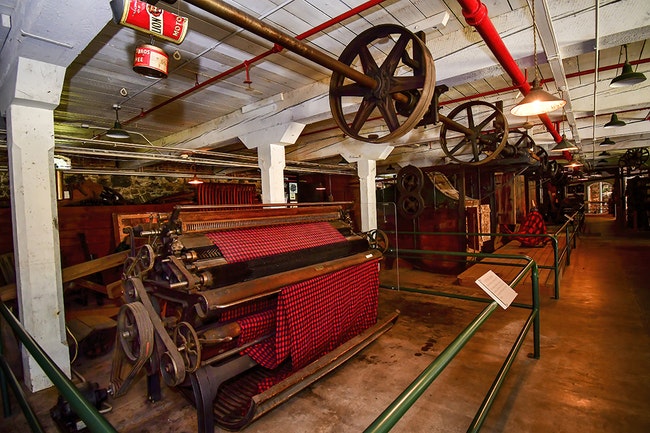
The Willamette Heritage Center is now providing a new way to learn the history of Salem’s Thomas Kay Woolen Mill. (Ron Cooper/Salem Reporter)
In these uncertain times, there’s a way to learn some fun facts about the Thomas Kay Woolen Mill and see how workers produced blankets and fabrics without leaving your favorite chair.
The staff at the Willamette Heritage Center partnered with Allied Video Productions to create a visual walking tour of the museum narrated by Tom Kay, the last private owner and operator of the mill.
Six hours of historical recollections that Kay recorded in 2010 were distilled into nine segments totaling about 45 minutes, said Kylie Pine, curator at the center.
The interviews can be found on the home page of the center’s website: willametteheritage.org.
Liz McIntire, the center’s marketing and events specialist, said “with Kay’s characteristic humor, he shares stories of his time working in the mill and of the people he knew or worked alongside.”
For instance, Kay recalls the times as a young boy when he hid among rolls of carpet to secretly observe employees and listen to their conversations.
He reminisces about how some “shrewd” Willamette Valley sheep farmers brought their bales of wool to the mill to be weighed before processing.
Often the bales had been left in the rain or were bundled with dirt and leaves to increase their weight, resulting in more money for the farmers.
Another story involves the frugality of previous members of the Kay family.
Employees crafted the hanging lights placed throughout the complex, which remain there today.
The owners decided that they could save money by not buying light bulbs for each fixture. So when employees shifted from one place to another while working, they took the bulbs with them to install at the next work station.
In the video, Kay, who lived from 1923 to 2018, pauses at several spots around the mill to explain who worked there and tells what they did.
“We were able to add a layer of photographs to the video to better help illustrate the stories, people and places mentioned,” Pine said.
“We had been working on this project for years and then came the pandemic and the museum closure, which actually allowed us some space in day-to-day operations to really be able to buckle down and get the materials together,” she said.
Thomas Lister Kay founded the textile mill in 1889, one of the first major industries in Salem. Kay selected Salem to erect his mill because citizens had pledged $20,000 to support the project and to provide a site near a water source.
The mill flourished for five years before it was destroyed by fire. The Kay family decided to continue at the location after Salem residents raised $25,000 for a new rebuilding.
That main building is 3 ½ stories high and constructed of bricks made locally. Dye and picker buildings were located nearby.
Following Kay’s death in 1900, Thomas Benjamin Kay took over the management of the mill, working until 1931. Ersel Kay took charge of the mill in 1932, and then his son Thomas Kay Jr. became manager when he returned from World War II.
He explains in the video that the mill closed in 1962 because synthetic fabrics were gaining in popularity. At the time, he said, wool garments couldn’t be found in any major store in the country.
Visitors who prefer to take the video tour while going through the mill can use their iPhones to scan codes on the signs at a number of exhibits and listen to what Kay has to say.
The mill at 1313 Mill St. S.E. is open from 11 a.m. to 4 p.m. Wednesday through Saturday.
The video was produced with contributions from Britta LION Franz, Diana Powers Evans, Elisabeth Walton Potter and Allied Video Productions.
 The Willamette Heritage Center is now providing a new way to learn the history of Salem’s Thomas Kay Woolen Mill. (Ron Cooper/Salem Reporter)
The Willamette Heritage Center is now providing a new way to learn the history of Salem’s Thomas Kay Woolen Mill. (Ron Cooper/Salem Reporter)
 The Willamette Heritage Center is now providing a new way to learn the history of Salem’s Thomas Kay Woolen Mill. (Ron Cooper/Salem Reporter)
The Willamette Heritage Center is now providing a new way to learn the history of Salem’s Thomas Kay Woolen Mill. (Ron Cooper/Salem Reporter)
 The Willamette Heritage Center is now providing a new way to learn the history of Salem’s Thomas Kay Woolen Mill. (Ron Cooper/Salem Reporter)
The Willamette Heritage Center is now providing a new way to learn the history of Salem’s Thomas Kay Woolen Mill. (Ron Cooper/Salem Reporter)
 The Willamette Heritage Center is now providing a new way to learn the history of Salem’s Thomas Kay Woolen Mill. (Ron Cooper/Salem Reporter)
The Willamette Heritage Center is now providing a new way to learn the history of Salem’s Thomas Kay Woolen Mill. (Ron Cooper/Salem Reporter)
 The Willamette Heritage Center is now providing a new way to learn the history of Salem’s Thomas Kay Woolen Mill. (Ron Cooper/Salem Reporter)
The Willamette Heritage Center is now providing a new way to learn the history of Salem’s Thomas Kay Woolen Mill. (Ron Cooper/Salem Reporter)
CONTACT Salem Reporter with news tips, story suggestions or questions by email at [email protected].
SUPPORT ESSENTIAL REPORTING FOR SALEM – A subscription starts at $5 a month for around-the-clock access to stories and email alerts sent directly to you. Your support matters. Go HERE.









